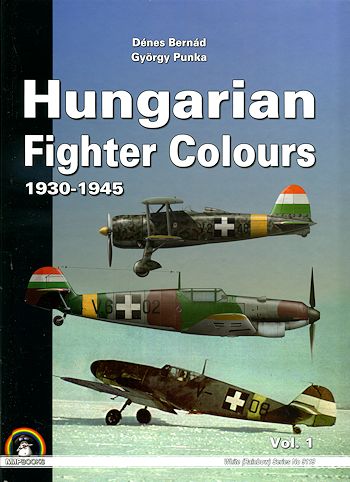MMP Books' Hungarian Fighter Colors vol 1
|
Author: |
Dénes Bernád &
György Punka |
|
Publisher |
Mushroom Models
Publications |
|
Price |
$69.00 SRP from
Casemate Publishing |
|
Reviewer: |
Scott Van Aken
|
|
Notes: |
#9119
ISBN 978-83-61421-71-9
182 pages, hardbound, 8x12 inches |
 What with all the concentration on camouflage and colors for the major powers,
it is often that some of the other participants in WWII get overlooked. Such is
the case for the Hungarian air force. Like Germany, Hungary was severely limited
in what they could put in the air and a national air force was strictly
forbidden. Unlike Germany, it took the nation quite a while to finally declare a
national air arm and that was in 1938.
What with all the concentration on camouflage and colors for the major powers,
it is often that some of the other participants in WWII get overlooked. Such is
the case for the Hungarian air force. Like Germany, Hungary was severely limited
in what they could put in the air and a national air force was strictly
forbidden. Unlike Germany, it took the nation quite a while to finally declare a
national air arm and that was in 1938.
However, it does not mean that there was no
air force as one had existed post WWI, and was secretly established once the
Entente had made Hungary's air military forbidden in 1920. The 'Bureau for
Aeronautic Affairs' was established in 1924 and was the basis for the resurgence
of the air force. Fighter types were ordered on a very small scale and brought
in unarmed as sporting planes during this time. Slowly the force grew, all the
while carrying civilian registration, similar to the method used by Germany.
Even when it was obvious to all but the blind that an air arm had been formed,
these planes still carried their civil codes. Once the air force was officially
underway as such, the Hungarians were able to purchase planes that it needed.
Most of these came from Italy who had been supplying them with a blind eye for
most of this period. It enabled the Hungarian Air Force to operate some
relatively modern equipment, at least modern by Italian standards and though
other types entered service, it wasn't until nearly the end of WWII that Hungary
was able to operate some of the latest types.
This is the first of a two volume set and
interestingly, it contains the table of contents for both volumes in it.
Naturally there is an introduction to the subject as to why the book is needed
and what was done in terms of research. This is followed by section to explain
the codes and other markings applied to Hungarian aircraft. What seems like a
bit of a jumble to the uninitiated is made quite clear in this section. There
follows a chapter on the various colors used during this period of time. While
most aircraft initially flew with the colors provided by the manufacturer, they
were repainted in Hungarian colors during their first overhaul. Those aircraft
made in Hungary got local camouflage from the start.
Then we get into the main body of the book
which is a look at each aircraft type used in the order that it entered service.
For volume one we have the Fokker D. XVI, Avis I-IV, Fiat CR.30, Fiat CR.32,
Fiat CR.42, Bf-109D, Bf-109E and Bf-109F. Each section not only gives a rundown
on the types service but also we are treated to a great selection of period
photos, a few of them in color. This is further enhanced by a large number of
full color profiles based on some of the photos that are in each section.
This is all followed up with several
appendices that include a list of ranks and the organization of fighter units.
In all, it is an outstanding book that is well researched, provides us with a
bevy of interesting photos and is just the perfect book for the modeler and
enthusiast alike. Highly recommended.
January 2014
Review book courtesy of
Casemate Publishing where
you can get yours.
If you would like your product reviewed fairly and fairly quickly, please contact
me or see other details in the Note to
Contributors.
 What with all the concentration on camouflage and colors for the major powers,
it is often that some of the other participants in WWII get overlooked. Such is
the case for the Hungarian air force. Like Germany, Hungary was severely limited
in what they could put in the air and a national air force was strictly
forbidden. Unlike Germany, it took the nation quite a while to finally declare a
national air arm and that was in 1938.
What with all the concentration on camouflage and colors for the major powers,
it is often that some of the other participants in WWII get overlooked. Such is
the case for the Hungarian air force. Like Germany, Hungary was severely limited
in what they could put in the air and a national air force was strictly
forbidden. Unlike Germany, it took the nation quite a while to finally declare a
national air arm and that was in 1938.